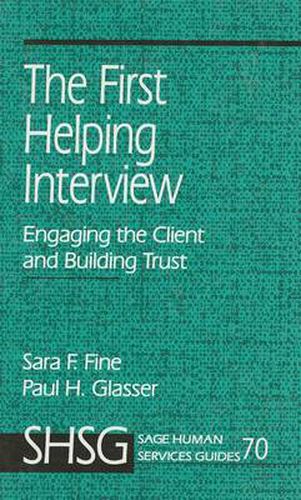Readings Newsletter
Become a Readings Member to make your shopping experience even easier.
Sign in or sign up for free!
You’re not far away from qualifying for FREE standard shipping within Australia
You’ve qualified for FREE standard shipping within Australia
The cart is loading…






Providing a practical handbook for practitioners in the helping professions, The First Helping Interview is a highly useful, easy-to-understand guide for both experienced and novice practitioners that reveals the steps involved in the crucial first meeting with a client. The authors approach the task of an initial interview by providing an overview of what the therapeutic process is and what to expect from clients, both those who seek help voluntarily and those who are required to get help. The book also covers the practical basics of therapy–counselor/client roles, physical settings, communication dynamics, assessment and diagnosis, record keeping, goals and contracts, and trust building. Separate chapters discuss special topics such as working with couples and families, the role of culture and ethnicity, when and how to refer clients with serious problems, and legal and ethical issues. Although this book is general enough to be used by any practitioner, the authors pay particular attention to specific settings, such as child protective services, crisis intervention, and corrections. Social workers, marriage and family therapists, school counselors, psychiatric nurses, child welfare workers, and probation officers will appreciate this valuable, indispensable reference tool.
$9.00 standard shipping within Australia
FREE standard shipping within Australia for orders over $100.00
Express & International shipping calculated at checkout
Providing a practical handbook for practitioners in the helping professions, The First Helping Interview is a highly useful, easy-to-understand guide for both experienced and novice practitioners that reveals the steps involved in the crucial first meeting with a client. The authors approach the task of an initial interview by providing an overview of what the therapeutic process is and what to expect from clients, both those who seek help voluntarily and those who are required to get help. The book also covers the practical basics of therapy–counselor/client roles, physical settings, communication dynamics, assessment and diagnosis, record keeping, goals and contracts, and trust building. Separate chapters discuss special topics such as working with couples and families, the role of culture and ethnicity, when and how to refer clients with serious problems, and legal and ethical issues. Although this book is general enough to be used by any practitioner, the authors pay particular attention to specific settings, such as child protective services, crisis intervention, and corrections. Social workers, marriage and family therapists, school counselors, psychiatric nurses, child welfare workers, and probation officers will appreciate this valuable, indispensable reference tool.